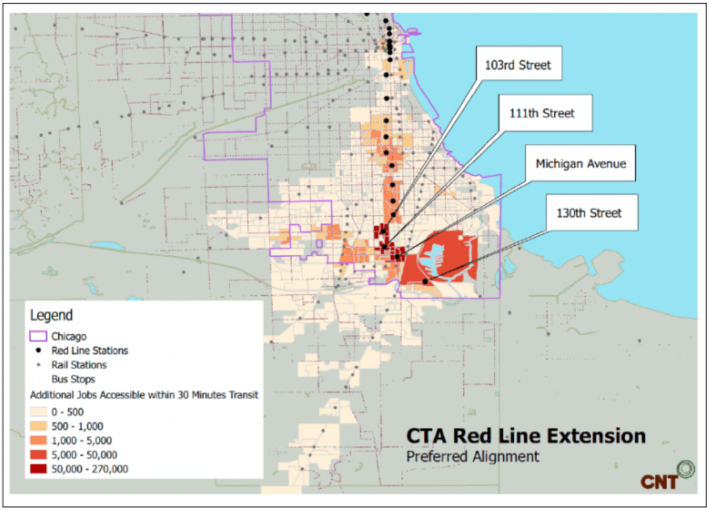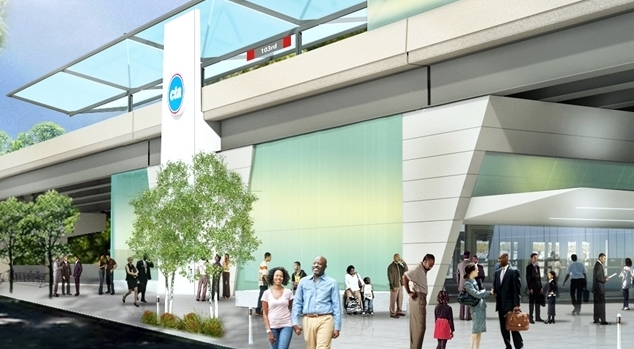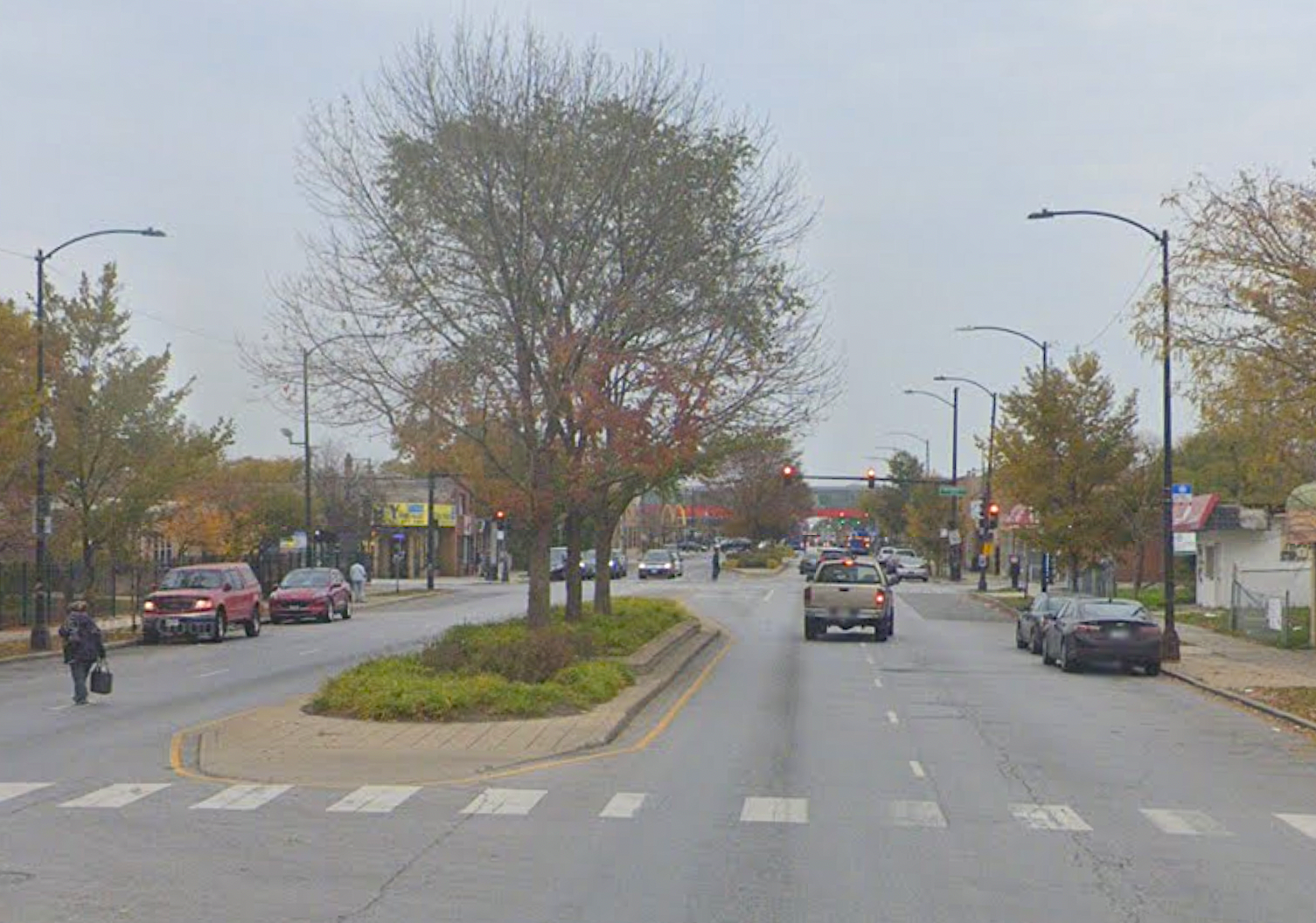There's a valid argument to be made that, given the current political and transit funding environment, it's not realistic to simultaneously advocate for extending the CTA Red Line south to 130th Street, as well as making upgrades to existing South Side Metra lines to provide rapid-transit service that's integrated with the 'L'. For example, Streetsblog Chicago cofounder Steven Vance recently said he is opposed to the $2.3 billion Red Line extension and would prefer to spend less money than that to beef up South Side Metra and bus service.
But in the case of last week's commentary in the Chicago Tribune titled "The CTA Red Line extension is a mistake — Metra is ready to better serve the South Side" by Manhattan Institute fellow Alex Armlovich and MI policy analyst Connor Harris, it's important to consider the source. The institute is a right-wing think tank, and its staffers have argued for transit funding austerity in the past. For example, senior fellow Aaron Renn claimed that only six U.S. cities deserve money for rail improvements, making the circular argument that because most American cities don’t currently have robust transit, we shouldn’t bother building it. (And that certainly wasn't the first time someone associated with the Manhattan Institute said wrongheaded things about sustainable transportation.)
As transit analyst Yonah Freemark noted in a 2018 interview with the Chicago Reporter, "The idea that we are having to choose between [the Red Line extension or upgrading South Side Metra] really speaks to the mentality in this country about how we invest in disinvested communities.” The Manhattan Institute is helping to promote that mentality.
So Armlovich and Harris, who live in New York City, aren't necessarily wrong in their opinion that we should focus on Metra upgrades instead of the Red Line extension. But when two out-of-towners on the payroll of an often-anti-transit organization exhort Chicagoans to "cancel" a rail project in an underserved neighborhood, skepticism is warranted.
On the other hand, it's worth noting that Aaron Renn (whom I mistakenly mentioned as an author of the Tribune commentary in a tweet -- apologies for the mix-up), tweeted this today:

- John Greenfield, editor
Since 1958, there have been plans for an ‘L’ extension to the Far South Side. However, those plans have consistently fallen through, leaving many Black communities with no fast and affordable transit connections to the rest of the city. The planned $2.3 billion south Red Line extension would be more than just a new rapid transit amenity, but would also provide Far South residents with equitable access to the rest of their city.
However, a recent Tribune opinion piece by Alex Armlovich and Connor Harris, from the conservative nonprofit think tank the Manhattan Institute, painted the Red Line extension as a wasteful "boondoggle." They argued that, while Chicago Mayor Lori Lightfoot is resisting the South Cook Fair Transit Pilot Project proposal for lower fares and more frequent service on the Metra Electric District and Rock Island District commuter rail lines, it would be more fiscally responsible to cooperate with than plan rather than pushing forward with the Red Line project, as Lightfoot is doing. (Earlier this month the CTA board approved spending $38 million for an environmental impact study for the extension.) Armlovich and Harris argued that the Red Line extension would be redundant to better Metra service, which could eventually be upgraded to rapid transit-style service and integrated with the 'L'.
However, last week at a seminar on the South Side Metra pilot proposal in West Pullman, local residents discussed the need for more convenient and less expensive Metra service, while also voicing supporting for extending the Red Line, with very good reason. While the Far South Side is currently served by the Metra Electric District and Rock Island District lines, they still do not fully cover the area.
The planned route of the Red Line extension would be a 25-30 minute walk from the MED, and 30-35 minutes from the RID. This is further than the distance between the Green Line and the Pink Line on the West Side, or the Brown Line and the Red Line on the North Side. In fact, the Green and Blue lines are never separated by more than about 0.75 miles, a roughly 15-minute walk, but both lines are valuable in serving the West Side. The rush-hour Purple Line Express, which runs adjacent to the Red Line for much of its route, is seen as an asset to the North Side, not a redundancy. The proposed south Red Line extension would be far enough from Metra lines to avoid undue service competition, even if the Metra Lines are eventually upgraded to 'L'-style service.

Armlovich and Harris also described the Red Line Extension as providing “inferior service” to an upgraded MED line without explaining their reasoning. Both the MED and RID lines serve different areas and needs of South Siders compared to the Red Line. The Red Line provides a one-seat connection to the North Side and direct transfers to all other ‘L’ lines. In contrast, the Metra lines primarily connect the South Side to downtown and the south suburbs. The Far South Side is a geographically large area of the city that cannot be fully covered by only two transit lines, which is why the Red Line extension would serve to complement rather than compete with Metra service.
The Red Line Extension would connect the Far South Side to neighborhoods such as Greater Grand Crossing, Englewood, Washington Park, and Bronzeville. The MED and RID lines do not stop in most of these communities, and each line only has one stop in Bronzeville. The Michigan Avenue business district in Roseland has historically been the beating heart of the Far South Side, and making it easier for people from multiple parts of the South Side to access it by transit would help support local businesses. Much of the MED on the Far South Side is still wheelchair inaccessible, and there are no immediate plans for ADA upgrades of these stations. The Red Line Extension would provide fair transit access to the rest of the city for Far South Side residents with disabilities.
A Center for Neighborhood Technology analysis highlighted additional benefits that improved Red Line connections would bring to surrounding communities. It found that the Red Line Extension would significantly increase the number of jobs accessible within a 30-minute transit commute. Near the new stations, an additional 50,000-270,000 jobs are expected to be accessible. This is especially pertinent given that a report by the RTA found that South Siders have longer commute times and employment densities than any other part of the city, in spite of having “relatively good transit access, comprised of several Metra and CTA rail lines, as well as robust CTA and Pace bus service.”

It's also worth noting that, as it stands, there would be no overlap between the South Cook Metra Pilot and the Red Line extension service. Metra hopes to run the pilot for three years, starting in 2020 and ending in 2023, but there's no guarantee the more frequent, affordable service will become permanent. Even if the CTA begins construction on the hoped-for 2026 start date, the extension will not be ready to ride until 2030 at the earliest. Ideally, the Metra pilot could continue while the extension is being built so that Far South Siders can have better transit access starting this year.
The Chicago Reporter has also discussed the need for both the Red Line extension and affordable, frequent Metra service. Transit analyst and Transport Politic blogger Yonah Freemark, discussed why having both improvements happen would be ideal. “The idea that we are having to choose between one or the other really speaks to the mentality in this country about how we invest in disinvested communities,” Freemark said. The Manhattan Institute is asking Chicago to make a false choice between one or the other, while in reality Far South Siders deserve both Red Line stations and better Metra service, which would provide fair and equitable transportation access.





